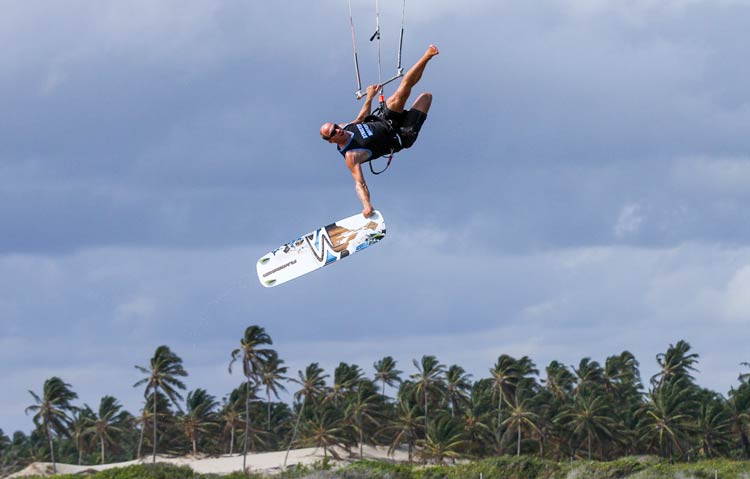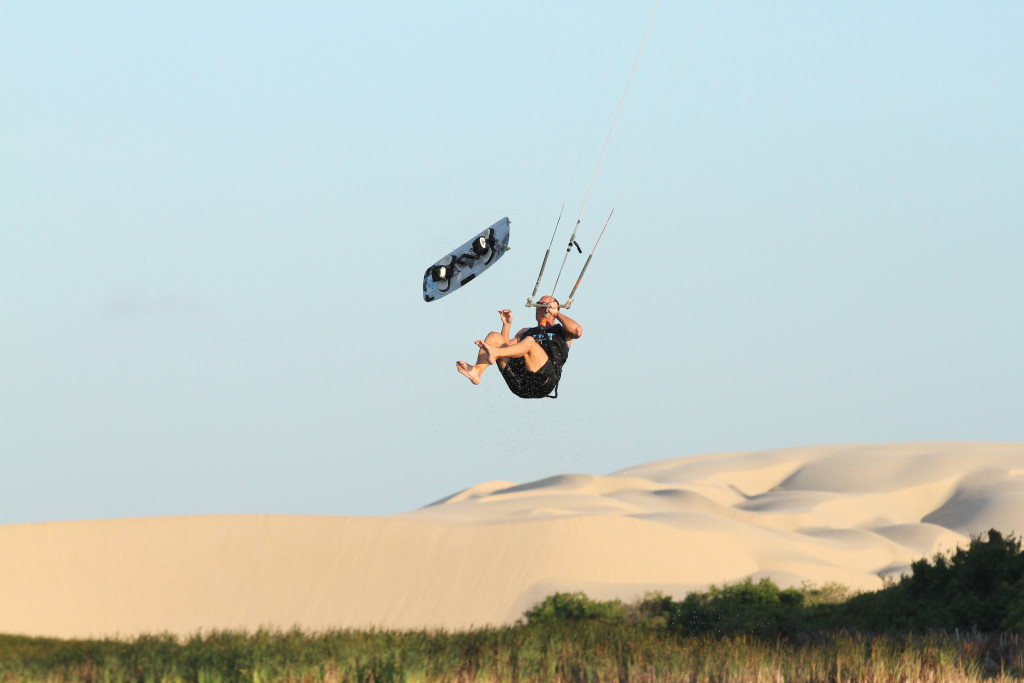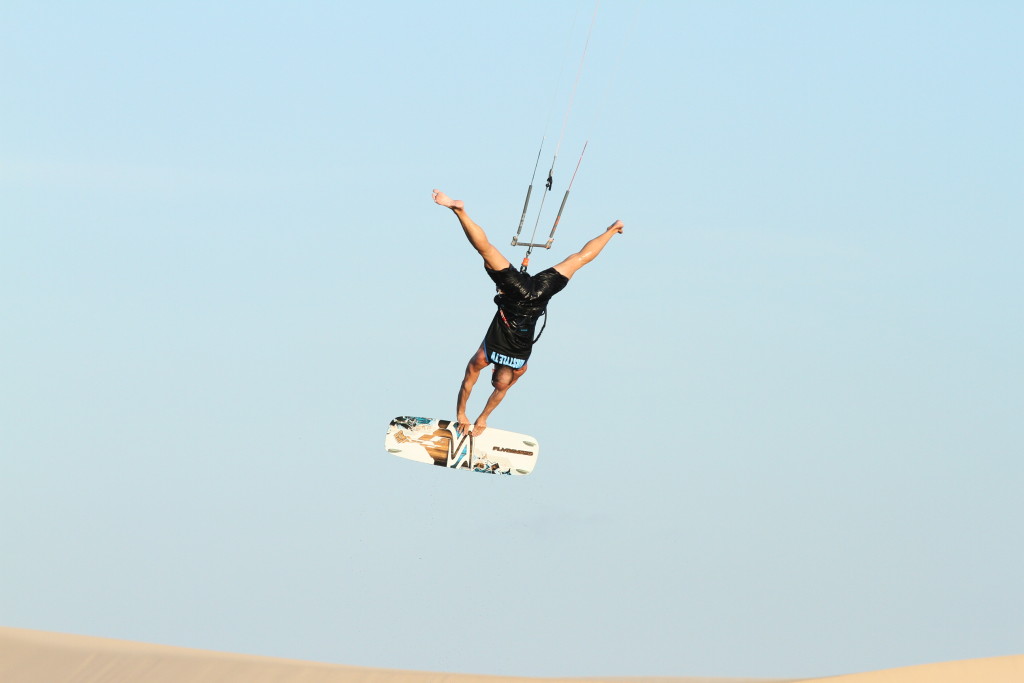What if you’re not interested in unhooking but want to progress in kiteboarding? Competition led freestyle isn’t for everyone and takes a lot of strength and skill to try the majority of it. If you can master a few basic tricks then there IS another way to take your kiting further and Toby Braeuer is probably the most well known kiter to have explored the alternatives.
Whether it’s his invention of Airstyle or his long running KiteForum.com, arguably one of the most popular kiteboarding forum websites, Toby is outspoken in his commitment to what he sees as the best way to show freestyle kiteboarding to anyone and everyone who will pay attention. We chatted with Toby one windless day in Tarifa to get some background on Airstyle and how best to start learning the 1300+ tricks he’s mastered so far…
You’re known for your ‘Airstyle’ tricks but what exactly is Airstyle?
Airstyle are hooked tricks only…therefore I call it “strictly hooked”. So any hooked tricks, like board-offs, slides, kiteloops, rotations, transitions etc.
How does it differ from ‘Big Air‘?
The big air competition on the world tour has 4 categories: board-offs, normal (e.g. rotations), kite loops and handle passes. Since handle passes are unhooked, it is not Airstyle. Plus in Big Air the height counts 70%, and while height is also important with Airstyle, it is not the most important, since Airstyle is associated with the best show possible. The higher you go the less tricks you can safely do and it becomes a bigger risk – one mistake, and that’s it. With Airstyle we do a lot of different tricks, including transitions and slides, which don’t count in Big Air competitions. But people love to see them!
Can you briefly explain the key elements that make up an Airstyle trick?
The key elements are below and you can build a trick by combining multiple elements together:
- Simple Tricks – anything not mentioned below, e.g. backrolls, deadman
- Grabs – anything grabbed, e.g. Front 1080 Nose Grab
- Transitions – any trick with a change of direction
- One Footers – take one foot out of the strap
- Board-offs – both feet out of the straps
- Passes – passing the board from one hand to the other
- Spins – spinning the board on the handle, tail or strap
- Flips – flipping the board on the handle or grab rail
- KickFlips – kicking the board so it flips
- Throws – throwing the board between your legs and then grabbing it again
- Kiteloops – any hooked in kiteloop, no matter if lower or higher
- Surface Tricks – Jesus Walks, Darkslides, Barefoot Slides and Superman Slides
- Beach Starts – jumping off the beach with other elements
- Water Starts – being in the water and lifting out of deep water with other elements incorporated
- Beach Landings – incorporating landing on the beach with other elements
There are so many tricks and progressions to learn – where should someone start? And how does someone know what to try next?
It is important to learn all the core elements like mentioned above. Ensure you can do each on its own and then once you have it all, you can combine several and your progression won’t stop – there are so many combinations!
The first trick everyone is landing the back roll.
The order of further progression after a standard back roll is like this:
- Backroll
- One Handed Backroll
- Grabbed Backroll
- Double Backroll
- No Handed Backroll
- Double Grab Backroll
…and then the same with the Frontroll.
For the Boardoff it would be like this:
- Boardoff
- Board Spin
- Board Flip
- Front 360
- Front 720
- Front 360 Board Spin
- Front 360 Board Flip
- Back 360
- Back 720
- etc
How do you go about learning a new trick, bring together the different elements to make one flowing trick?
Since I can do all Airstyle elements, I just combine them for a new trick. I get ideas about what could work, I note them on my lists, and then I go onto the water and try it. Or I land a new trick, then I can immediately add a new element to it, since the feeling will be similar.
Many times I can land new tricks on the first attempt, but if not, I try and understand what went wrong and correct what’s needed to land it. Sometimes I may over rotate, jump too low, steer the kite incorrect etc. It’s important to think and look critically and what you are doing and find the mistakes.
Good power is very important and the right power from the kite makes tricks possible. With less power I can try and try to land a certain trick, while I just need one attempt when I have more power.
What is your latest trick? What made it challenging to you to learn?
My latest trick is a KickFlip Barefoot Slide Indy Flip. I pop, kick flip the board so it rotates around its axis, catch it on the rail, land barefoot on the water, slide on my feet, and while I slide I flip the board on the rail again, catch it, start the kite loop and get back into the straps, land and keep riding.
It wasn’t so challenging for me, since I can do the 3 elements (kickflip, slide and flip) easily.
What are the most important tips/skills for airstyle?
- You need to know how to jump and keep the kite in the zenith, without moving it too much.
- You need to hold down good power in the kite and some flexibility. I am 43 years and not very flexible, but you shouldn’t be too stiff.
What’s different about the equipment you use for Airstyle?
The right equipment is key for Airstyle. If I don’t have the right gear, I will ride like an average rider.
The slower the kite, the more tricks you will land. It can be too slow if you want to do surface tricks like Jesus Walks, since you still need to be able to loop the kite. On my North Rebel 18, I use 32m lines and I use the inner connection of the bar…so this is very slow already.
Therefore I ride a big kite like the 18, since it is slow, and also gives me the power I need to land the tricks. It is more about hang time, than height. While smaller kites jump higher, they also sink faster, the flying curve is less regular and you want to fly predictable and in control, with as little kite movements as possible.
The bar is very important. While a good stopper will work, a microloop (that hooks the bar close to you on full power) will make you land tricks on much higher levels.
The board is not that important, but it shouldn’t be too big, since you need to edge harder to control a bigger kite, and you can flip and spin it around easily. For Kick Flips it also shouldn’t be too light, or the wind effects the rotations.
Important on the board are straps, which can be set to a big size, since you need to get out and into the straps real quick. If you twist your front foot and lift your toes, you will have no problem of slipping out.
A higher, stiff handle is very important to give direct control to what you want it to do and it won’t hurt your fingers when grabbing the handle during flips.
In addition you might want to consider a seat harness, this way the power of the kite will not hurt your back. I use a hybrid harness, which is a seat harness, but the hook sits higher, which is better for the boardoffs.
Would you like to see further developments in equipment to suit this side of the sport?
Yes, of course. Since 2012 we don’t have bars with microloops. There is a market which needs supply! And we need kites that have great lift and hang time, while NOT turning too fast. Most kites turn too fast nowadays, which results into big crashes when you make just a little steering mistake.
What conditions do you need?
I fly only one size – 18sqm. I can have fun from 15-25 knots. Around 20 knots I have good power without fighting it too much.
Also flat water helps alot. Waves are nice ramps but then I cannot perfectly do the surface tricks.
Warm water will also add to my perfect conditions, since a wetsuit makes you less flexible.
How would you like to see this side of the sport develop?
I am always confused about what is going on in the sport. Although 99% of the people I talk to share the same thoughts, barely anyone is doing something to bring back this discipline. If the sport wants to grow, they need to promote Airstyle, since it attracts way more people than any other discipline, with its stylish, smooth, spectacular and not too risky looking tricks.
Why do you think it’s not already popular?
Kiteboarding as a sport follows a few riders who want the sport to be as extreme as possible. They live for it, so they can’t be blamed.
Companies, world tours and the organizers should be blamed for showing a small part of the sport that is not attractive to people on the beach and media. Once sales go down and only riders watch themselves during competitions, they will understand, that they went the wrong way.
Luckily the world tour brought back Big Air, which in my opinion was the most important step in the sport in the last 10 years.
Now event organizers should be given the option to choose their disciplines and we will see which discipline will be the most important in the sport. To stop Big Air becoming boring or repetitive, elements like slides should be added and then we will see a fantastic show on the water.
But, we should have events for every disciplines. Our sport has so much diversity, we should show it all!
That in mind, I have a fantastic concept, which needs a sponsor…


